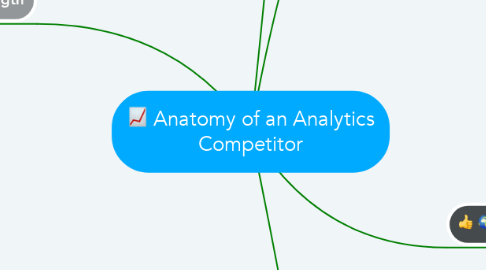
1. Senior executive advocates
1.1. Changes
1.1.1. Culture
1.1.2. Processes
1.1.3. Behavior
1.1.4. Skills
1.2. Leadership
1.2.1. CEO
1.2.1.1. Requires: appreciation & familiarity
1.3. Not all decisions-Analytics
1.3.1. Also: Informed instinct & anecdote
2. Sources of Strength
2.1. Right focus
2.1.1. Where to direct efforts
2.1.2. Deep analysis
2.1.3. Not only own navels
2.1.3.1. Also customers and vendors
2.2. Right Culture
2.2.1. Culture: soft concept
2.2.1.1. Analytics: hard discipline
2.2.2. Hard facts
2.2.3. Rigorous metrics
2.2.3.1. Compensations & rewards
2.2.4. Tension
2.2.4.1. Innovative impulses vs evidence
2.3. Right People
2.3.1. Analytical firms
2.3.1.1. Hire analytical people
2.3.1.1.1. Conceptual problem-solving
2.3.1.1.2. Quickly learn
2.3.1.1.3. Project management
2.3.1.1.4. Software applications
2.3.1.1.5. Improvement tools
2.3.1.1.6. Complex ideas
2.3.1.1.7. PhDs with personality
2.3.2. Difficult to find
2.3.2.1. Not general utility
2.3.2.1.1. Rather an active part
2.4. Right Technology
2.4.1. Competing on analytics
2.4.1.1. Competing on technology
2.4.2. Constantly
2.4.2.1. Monitor IT
2.4.2.2. Push IT
3. Serious Analytics
3.1. Require
3.1.1. Data Strategy
3.1.1.1. How to
3.1.1.1.1. Present it
3.1.1.1.2. Integrate it
3.1.1.1.3. Store it
3.1.1.1.4. Easily accesible
3.1.2. BI Software
3.1.2.1. Tools that allow
3.1.2.1.1. Extract
3.1.2.1.2. Transform
3.1.2.1.3. Load
3.1.2.2. Tools that deliver
3.1.2.2.1. Reports
3.1.2.2.2. Alerts
3.1.2.2.3. Scorecards
3.1.3. Computing Hardware
3.1.3.1. Great capacity
3.1.3.1.1. 64-bit processors
3.1.4. The Long Road Ahead
3.1.4.1. Agressive analytics
3.1.4.1.1. Leaders in their fields
3.1.4.2. Seek upper hand
3.1.4.2.1. Optimize business processes
3.1.4.3. News analytics competitors
3.1.4.3.1. Stock their personnel larders
3.2. To stake out the limits of the knowable
4. Widespread use of modeling and optimization
4.1. Look beyond
4.2. Identify profitable customers
4.3. Optimize supply chains
4.4. Establish prices in real time
4.5. Create complex models
4.5.1. Sophisticated experiments
5. An enterprise approach
5.1. Improve business functions
5.1.1. sophisticated quantitative techniques
5.2. All activities as a single
5.3. Business Intelligence
5.3.1. Managed by departments
5.3.1.1. Chaos lies
5.3.1.2. Proliferation os spreadsheets
5.3.2. Field centralize groups
5.3.2.1. Critical data well managed
5.3.2.2. Share data easily
